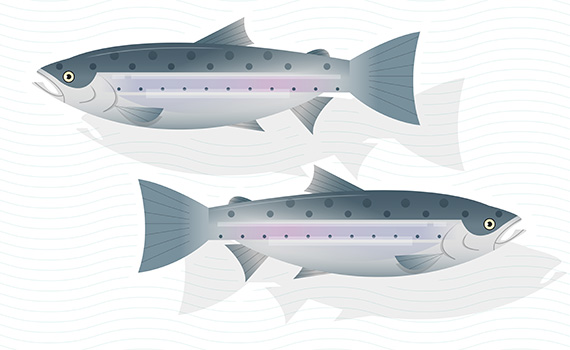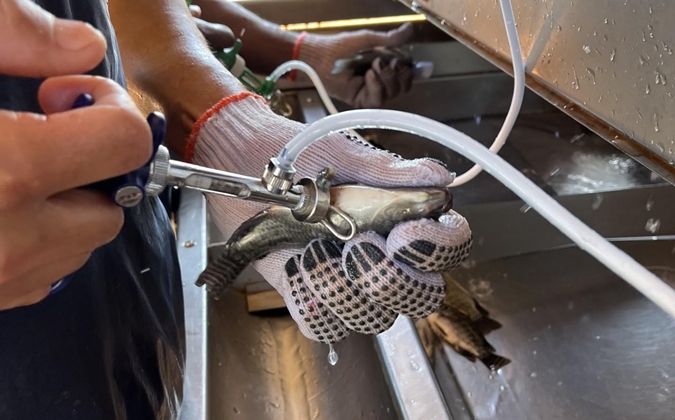
Vaccine ‘work in progress’ in major aquaculture markets, Part 3: Atlantic salmon
The scientific journal Vaccines recently published a review of “the most significant and innovative vaccine research” in three economically important fish species: European sea bass, Nile tilapia and Atlantic salmon. In this three-part series, the editors of Fish Health Forum summarize the main findings for each species.
While there are efficacious commercial vaccines available against a number of important diseases that affect Atlantic salmon, there are still pathogens for which there are currently no such options available. The latest research aimed at filling these knowledge gaps includes a range of studies across bacteria, viruses and parasites.
Effect of antibody response not always clear
A formalin-inactivated vaccine with mineral oil adjuvant against Tenacibaculum finnmarkense, the causative bacterium of tenacibaculosis, proved ineffective in one piece of work, explained the review’s authors.
This finding illustrated that high antibody response, as seen in the study, does not necessarily mean that immunity is conferred, they said, pointing to the fact that in challenges, controls had lower mortalities than vaccinated fish.
The reverse scenario was seen in a study exploring a vaccine against Yersinia ruckeri, which causes enteric redmouth disease in salmonids. Without finding a notable antibody response, higher survival rates were observed in vaccinated fish when challenged. A note of caution was sounded, however.
“The fact that bacterial cells were retrieved from both vaccinated/surviving and control groups at 15 weeks post vaccination indicates that, although protected from the disease, fish can become asymptomatic carriers, a fact that might have serious implications in high-density fish farms,” the scientists explained.
Different inactivation methods were explored in the research, and vaccination by single-dip immersion, as applied in the work, “should be further explored,” they added.
Oral vaccines against viral pathogen explored
Infectious salmon anemia (ISA) is a serious viral disease affecting salmon aquaculture, and while there are commercial vaccines available, delivered by intraperitoneal (IP) injection, the review’s authors looked at a piece of work exploring recombinant DNA vaccination, administered orally. Vaccinated fish in the study saw 64% relative percent survival, the scientists reported, with a significant increase in antibodies against the disease-causing virus.
“These results demonstrated that the oral vaccination route and the recombinant DNA technology can protect salmon from ISA. Taking into consideration the stressful conditions to which IP injected fish are subject when vaccinated against ISA with commercial formulations, the present paper describes a promising alternative,” they explained.
In a major study cited by the authors, oral administration also proved effective as a booster, following IP vaccination against ISA virus and the bacterium Piscirickettsia salmonis, the cause of piscirickettsiosis in salmonids.
“The use of boosters was associated to a reversion to protective levels of antibodies; when not scheduled, pathogens inflicted severe mortalities that could not be prevented by antibiotics,” the researchers explained, while also drawing attention to the large size of the dataset created by the research.
A key issue for oral vaccines is uneaten food bearing recombinant DNA ending up in the natural environment, the researchers explained, but if effective measures to prevent this happening are taken, “orally delivered vaccines will have a chance in the aquaculture industry.” They cited another study where an oral vaccine against infectious pancreatic necrosis virus proved more successful than the injection route.
Assessing recombinant DNA vaccines
A recombinant DNA vaccine against ISA virus was tested with and without supplementary plasmids and delivered by intramuscular injection. Differing levels of antibody responses were noted, the authors said, but with no experimental challenge, more work is needed.
“An experimental challenge will be necessary in the future to help evaluate the real efficacy of the vaccine in view of commercial exploitation; if good results will be found, a similar formulation may be viable for vaccines against other viruses,” they suggested.
Considerable research has been dedicated to finding a vaccine against piscine orthoreovirus (PVR), which causes heart and skeletal muscle inflammation disease. In one study, a formalin-inactivated vaccine adjuvanted with mineral oil performed well against a control of a commercial vaccine containing no PVR antigen, the scientists explained, with less severe or no heart lesions detected.
A recombinant DNA vaccine using combinations of PVR genes saw increased expression in relevant anti-viral genes, they said, though only those fish receiving a smaller number of specific plasmids saw significantly reduced viral load in the blood and heart lesions.
New techniques offer hope of parasite control
A small number of experimental vaccine strategies against parasites were described as “promising” by the review’s authors.
An attenuated vaccine against Cryptobia salmositica, a flagellated protist normally transmitted by a leech, is one such option. Using an isolate from the leech Piscicola salmostica, fish of approximately 300g were vaccinated and monitored.
“Parasitemia and antibody titer patterns shifted by 3 months, peaking at 5 and 8 weeks post vaccination, respectively, and by 9 weeks post vaccination parasites were undetectable in all fish,” the scientists said.
Vaccines address problem sea louse species
Using a novel protein obtained from the sea louse Caligus rogercresseyi and expressed in Escherichia coli, a recombinant vaccine was produced for use in freshwater, then as a booster after saltwater acclimatization, the authors continued.
“The recombinant vaccine was efficacious only against the second parasite generation,” they noted, but the vaccine showed promise in delaying the life cycle of the species, which is particularly prevalent in salmon aquaculture.
The review also highlighted a recent study exploring vaccination options using a protein produced by E. coli against the salmon louse, Lepeophtheirus salmonis. IP vaccination both with and without a supplementary bath immunization was used, with a booster.
“Although not statistically significant among groups, IP-vaccinated fish suffered from less attached lice, which were impacted in terms of fecundity (lower gravid female count) and developmental success (delayed hatching),” the authors explained.
Although not a vaccine, the researchers also commented on an RNA interference method against L. salmonis.
“This procedure could lay the foundation for future developments of novel drugs or vaccines, provided its efficiency and longevity against the copepodid infective stage is consistently demonstrated,” they concluded.
To view the full review in Vaccines, click here.
Posted on: June 09, 2021






